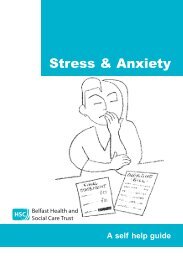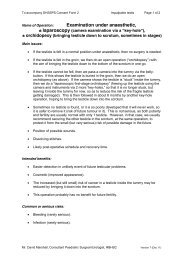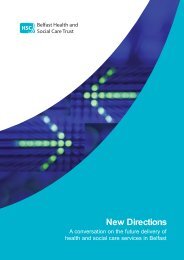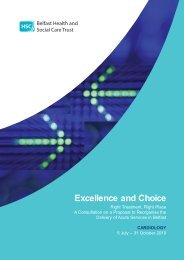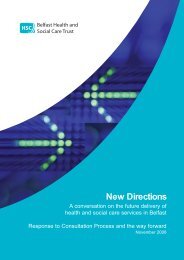Annual Report 2009 -2010 - Belfast Health and Social Care Trust
Annual Report 2009 -2010 - Belfast Health and Social Care Trust
Annual Report 2009 -2010 - Belfast Health and Social Care Trust
- No tags were found...
You also want an ePaper? Increase the reach of your titles
YUMPU automatically turns print PDFs into web optimized ePapers that Google loves.
PartnershipsWE WILL WORK COLLABORATIVELY WITH ALL STAKEHOLDERSAND PARTNERS TO IMPROVE HEALTH AND WELLBEING ANDTACKLE INEQUALITIES AND SOCIAL EXCLUSIONShopmobility scheme at The Royal HospitalsThe Shopmobility service at The Royal Hospitals has made getting around the hospital <strong>and</strong>accessing services much easier for patients. The service, which grew from a partnership withShopmobility <strong>Belfast</strong>, is aimed at assisting users with limited mobility now also provides a SightedGuide scheme for patients <strong>and</strong> visitors with a visual impairment. The Sighted Guide scheme evolvedthrough a partnership between Shopmobility <strong>and</strong> <strong>Belfast</strong> <strong>Trust</strong>’s Sensory Support Team who trainedthe Shopmobility volunteers as sighted guides.Shopmobility is a free service which offers self-propelling wheelchairs <strong>and</strong> mechanised scooters tousers who need assistance accessing the hospital site. Statistics for this year reveal that since theservice started, almost 2000 patients <strong>and</strong> visitors have used the service, highlighting the need forthe scheme.The 80 acre site at the Royal Hospitals can be daunting for users with limited mobility, however, therecent statistics reveal that more <strong>and</strong> more users who need assistance accessing the hospital arefinding the service provided by the scheme most beneficial.Shopmobility at the Royal is located near the disabled car parking bays in the public car park besidethe School of Dentistry.Working collaboratively to reduce health inequalities in <strong>Belfast</strong><strong>Belfast</strong> has the highest levels of deprivation in Northern Irel<strong>and</strong>, with some 40% of the mostdeprived local areas being within <strong>Belfast</strong> Local Government District. These higher levels ofdeprivation translate not only into lower life expectancy but a greater burden of disease <strong>and</strong>consequently a greater dependence on health <strong>and</strong> social care services. While health hasimproved in the last decade, inequalities in life expectancy between <strong>Belfast</strong> <strong>and</strong> more affluentareas, such as Castlereagh, are widening.Professor Sir Michael Marmot, in his review on health inequalities in Engl<strong>and</strong> published in February<strong>2010</strong>, stated that ‘the key drivers of health <strong>and</strong> health inequalities lie outside the healthcaresystem. What is important is where people are born, where they grow up, their work <strong>and</strong> howthey live an age’. So what is our contribution to reducing health inequalities working within thehealthcare system? The <strong>Belfast</strong> <strong>Trust</strong> has developed a <strong>Health</strong> Inequalities strategy <strong>and</strong> plan ofaction to be taken by the <strong>Trust</strong> to address its overarching purpose of reducing inequalities in thehealth. The recommended actions are as follows:19



